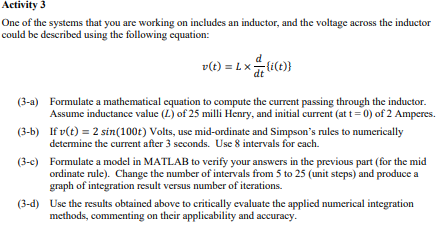equation to com ormulate a mathematical ssume inductance value (L) of 25 milli v(t) = 2 sin(100t) Volts, use mid-on termine the current after 3 seconds. Us
equation to com ormulate a mathematical ssume inductance value (L) of 25 milli v(t) = 2 sin(100t) Volts, use mid-on termine the current after 3 seconds. Us
Algebra & Trigonometry with Analytic Geometry
13th Edition
ISBN:9781133382119
Author:Swokowski
Publisher:Swokowski
Chapter5: Inverse, Exponential, And Logarithmic Functions
Section: Chapter Questions
Problem 18T
Related questions
Question

Transcribed Image Text:Activity 3
One of the systems that you are working on includes an inductor, and the voltage across the inductor
could be described using the following equation:
d
v(t) = L x = (i(t))
dt
(3-a)
Formulate a mathematical equation to compute the current passing through the inductor.
Assume inductance value (L) of 25 milli Henry, and initial current (at t = 0) of 2 Amperes.
If v(t) = 2 sin(100t) Volts, use mid-ordinate and Simpson's rules to numerically
determine the current after 3 seconds. Use 8 intervals for each.
(3-b)
(3-c) Formulate a model in MATLAB to verify your answers in the previous part (for the mid
ordinate rule). Change the number of intervals from 5 to 25 (unit steps) and produce a
graph of integration result versus number of iterations.
(3-d) Use the results obtained above to critically evaluate the applied numerical integration
methods, commenting on their applicability and accuracy.
Expert Solution
This question has been solved!
Explore an expertly crafted, step-by-step solution for a thorough understanding of key concepts.
Step by step
Solved in 2 steps

Recommended textbooks for you

Algebra & Trigonometry with Analytic Geometry
Algebra
ISBN:
9781133382119
Author:
Swokowski
Publisher:
Cengage

Algebra & Trigonometry with Analytic Geometry
Algebra
ISBN:
9781133382119
Author:
Swokowski
Publisher:
Cengage